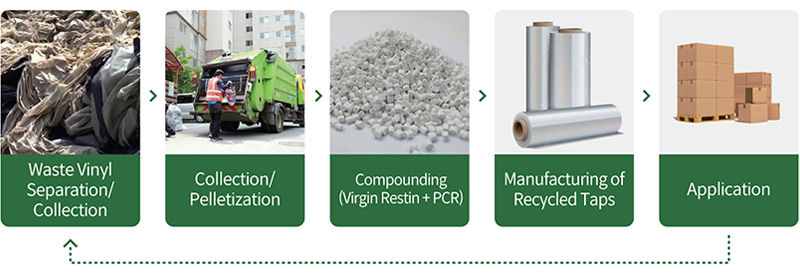Oxo-Biodegradable protective tape
What are the characteristics of Oxo-Biodegradable plastics?
The characteristics of Oxo-Biodegradable plastics
- Raw Materials Used Oxidative biodegradation agents, plant-based materials, etc.
- TypesOxo Bio-PE, OXO Bio-PP, etc.
- Specification StandardsASTM D6954, UAE S 5009
- AdvantagesAdjustable biodegradation period, excellent properties, maintained transparency.
- DisadvantagesRequires oxidative degradation (heat, UV), currently applicable to films only.
- Biodegradation MechanismMicrobial degradation after oxidative degradation.
- Availableuniversal plastic material.
- Recyclablebiodegradation period of 1-5 years.
Oxo-Biodegradable protective tape
How does the degradation process work?
The degradation process

Biodegradable protective film
What is 'biodegradable,' the leader in eco-friendliness?
Definition
Biodegradable materials are gaining attention as they can replace plastics, unlike non-degradable plastics that do not rot when buried in the ground.
Biodegradable materials decompose naturally in the environment, typically within a minimum of 180 days, facilitated by microorganisms.
We use PLA (Poly lactic acid), PBAT (Polybutylene Adipate-co-Terephthalate) mixed with PLA, and cornstarch to develop and manufacture products such as mulching film, packaging materials, and containers. We have established a production system for these products
While conventional biomass products often leave behind microplastics as they do not decompose over time, our products are 100% biodegradable when buried in the ground, leaving no harmful residues. Additionally, our environmentally friendly products do not produce harmful substances like dioxins when incinerated.

- A product that reduces the decomposition period from over 1,000 years of conventional plastics to a minimum of 3 months and a maximum of 5 years.
- During the decomposition process, no microplastics are generated, and the product serves as food for microorganisms through enzymes, causing no harm to the soil.
Industrial Protective Film
What are the differences between biodegradation and oxidative biodegradation?
The differences between biodegradation and oxidative biodegradation
| Classification | Biodegradable Plastics | Oxo-Bio degradable Plastics |
|---|---|---|
| Materials | 100% biodegradable materials such as corn-based polylactic acid (PLA), cellulose, and chemical polymers (PBAT) Up to 6 months |
Bio-PE, Bio-PP…, and others are a combination of conventional plastic materials, eco-friendly (biomass) materials, and biodegradation promoters. 3 months - 5 years |
| Degradation | Decomposed by microorganisms | Oxidation and degradation due to heat, UV, etc. |
| Advantages | Decomposed by microorganisms, so even if it is plowed over with a tractor during degradation, it continues to decompose underground with the help of microorganisms. | Cheaper raw materials compared to biodegradable plastics. |
| Disadvantages | Expensive raw materials Has a relatively short shelf life due to decomposition by microorganisms. |
Does not decompose when plowed under with soil due to oxidation and degradation by heat and UV. There is a risk of very small microplastic fragments remaining, potentially causing soil contamination. |
| Certification | Eligible for environmental label certification (EL724) as a biodegradable resin by the Ministry of Environment. | Not eligible for certification from the Ministry of Environment. Certification related to bio-based plastics standards can be obtained from the Korea Bio-materials Packaging Association. |
Industrial Protective Film
How does the recycling process work?
The recycling process













